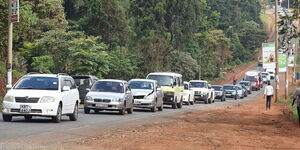Two pedestrian crossing signs became the subject of discussion online, with road users and motorists sharing their diverse understandings of them.
One had a blue background, while the other had a red boundary with zebra-like stripes enclosed in both diagrams.
The signs are erected strategically on various roads in the country to pass a specific message to road users, including motorists and pedestrians.
Pedestrian Crossing Sign With Blue Background
The pedestrian crossing sign with a blue background falls under the class of road signs in Kenya referred to as Regulatory Signs.
Regulatory Signs have a blue or white background, most enclosed in circles, octagons or inverted triangles.
These signs are placed at the exact place where pedestrians are expected to cross the road.
Pedestrian crossing with blue background targets road users on foot, informing them they can cross the road at that designated point without risking their lives and that of other motorists.
Pedestrian Crossing With Red Boundary
Ordinarily, they are known as harsh signs. They fall under Warning or Class B signs.
These prohibitory road signs are meant to pre-empt a hazard ahead and prepare the driver to take action. Signs falling under this category are mainly red with black symbols.
The pedestrian crossing with the red boundary warns motorists to slow down because there is a designated crossing point set for pedestrians ahead.
The difference between the two signs is that the one with the blue background is placed at an exact point where pedestrians are expected to cross the road, while the one with a red boundary targets motorists informing them of a pedestrian crossing ahead.
Besides the two, another sign shows a person sitting in a wheelchair on a pedestrian crossing. This sign is used to inform motorists that physically impaired people are crossing the road.
Other common warning signs in the country include falling rocks ahead signs, speed bump road signs, traffic merging head signs and uneven roads surface ahead road signs.
Traffic light signage fall under Category C, which represent different instructions and alerts to road users.
Category D represents road markings and kerbs. They are usually yellow or white markings to separate incoming traffic on the single-carriage road.
Some are continuous lines, while others are broken to pass different messages.
The National Transport and Safety Authority (NTSA) expects drivers to understand the signs before approving their driving licenses.












